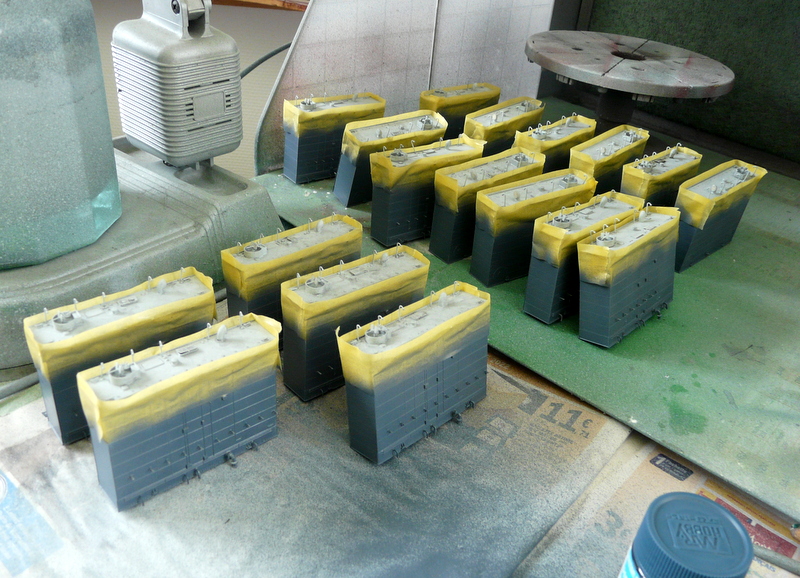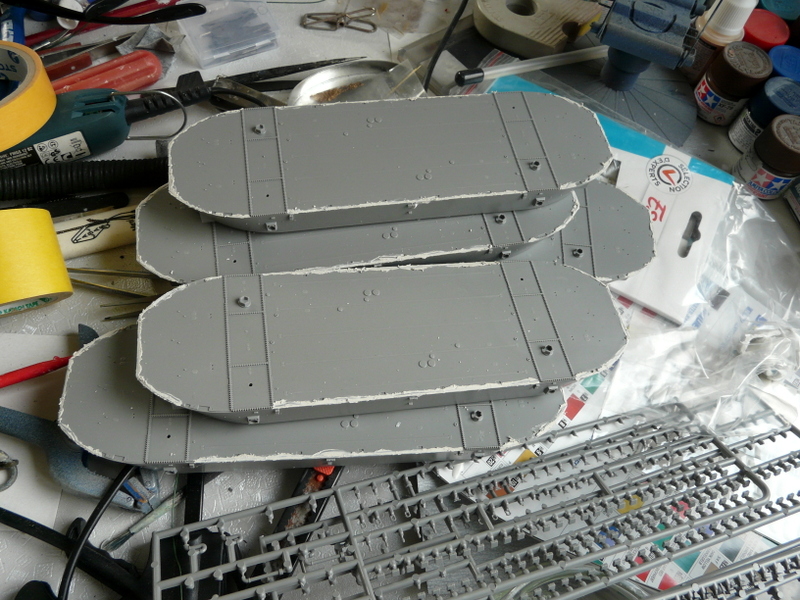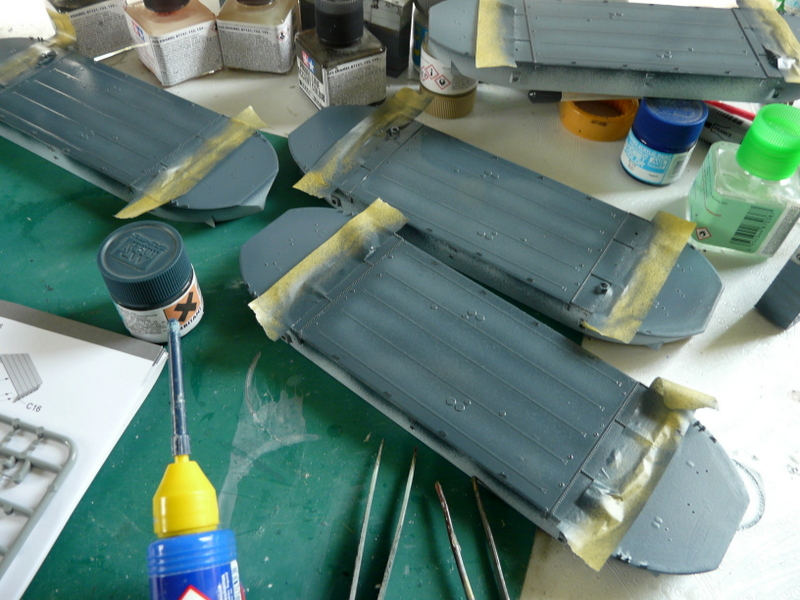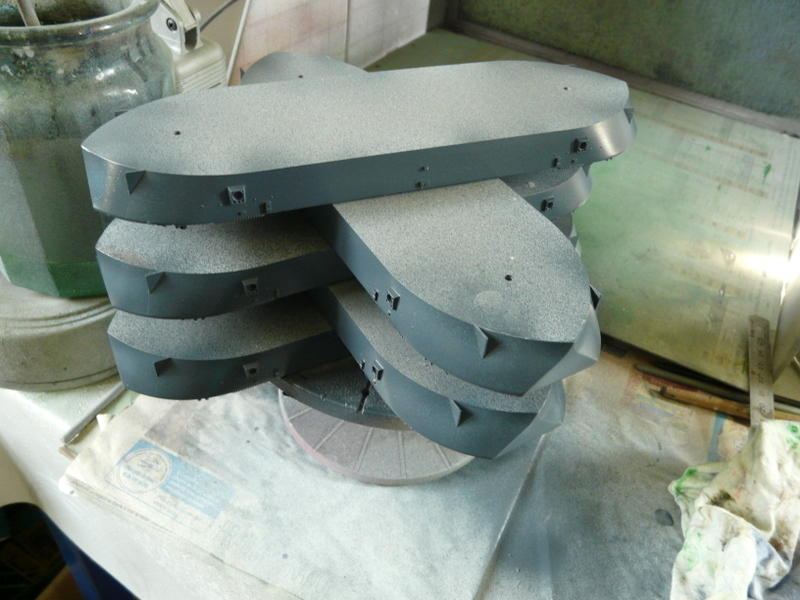Aaaaaaah !!!! tentation !!!!! va-t-en !!!!! Pourquoi, ça tombe toujours sur moi ??? Et oui ! TAKOM, nous sort un dock flottant au 350 ème. Je n’étais pas indifférent à cette sortie, car j’ai suivi sur les réseaux dit « sociaux », le carénage du bateau-musée USS TEXAS dans le-dit dock flottant avec des images superbes. J’avais dans mon stock l’USS TEXAS et voilà…… c’est pas ma faute, je suis faible et j’ai acquis rapidement cette nouveauté.
Au niveau poids, on en a pour son argent, la boîte est pleine comme un oeuf. Avec en plus toute la photodec fournie d’office dans le coffret, donc pas de plus-value à rajouter.
Aaaaaaah!!!!! temptation!!!!!! go!!!!!! Why, it always falls on me?? And yes! TAKOM, we take out a floating dock at 350 ème. I was not indifferent to this outing, because I followed on the so-called « social » networks, the fairing of the ship-museum USS TEXAS in the said floating dock with superb images. I had in my stock the USS TEXAS and here…… it’s not my fault, I’m weak and I quickly acquired this novelty.
In terms of weight, we get value for money, the box is full as an egg. With all the photodec included in the box, so no added value.
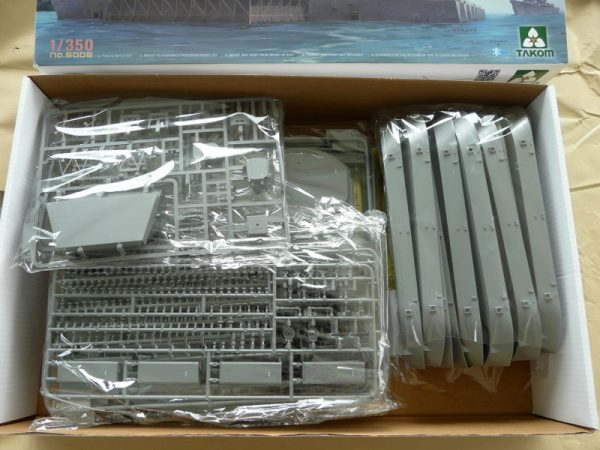

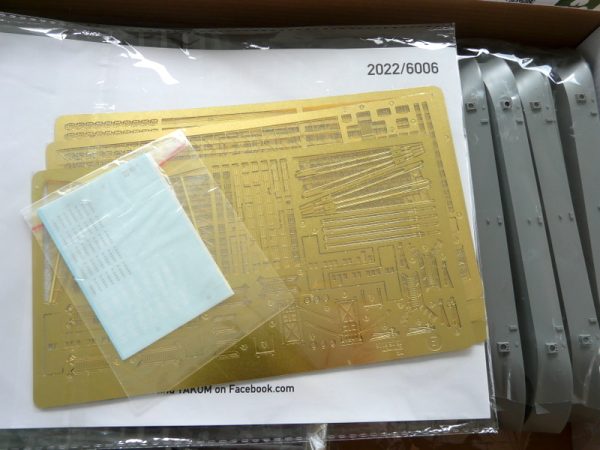
et voilà mon projet ! ( enfin, ce que j’espère !) and here is my project! ( finally, what I hope!)
‘espère ! )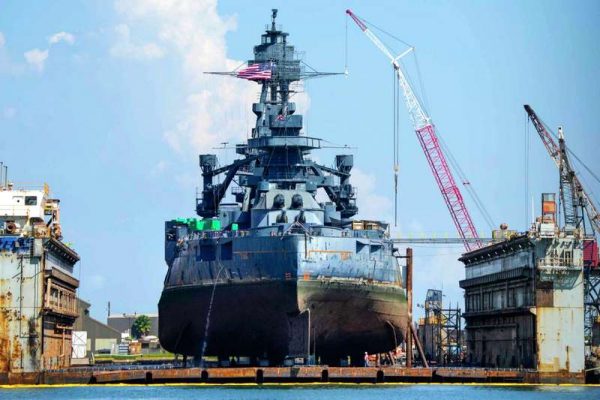
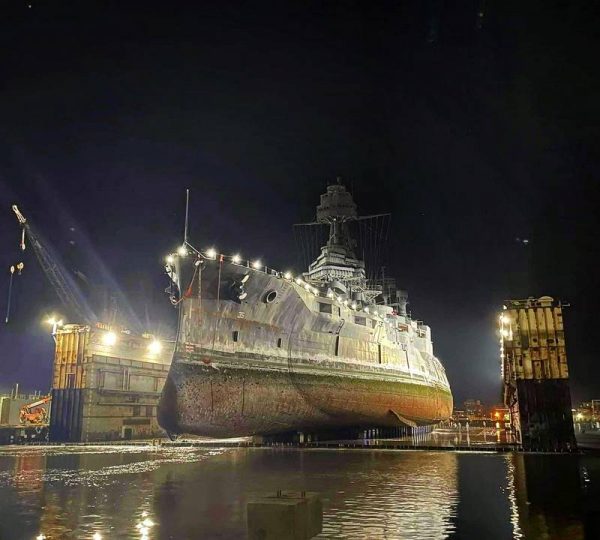
Le dock se compose de 10 barges, assemblées avec une paroi de chaque côté, donc si vous me suivez, cela fait 20 coffres à monter. Le travail est fastidieux. En fin de compte, ce sont des boîtes avec 6 côtés à assembler. TAKOM a prévu le montage astucieux de 5 côtés avec des encoches (on ne peut pas se tromper) sauf pour le dessus (va savoir pourquoi cela a été oublié ?). The dock consists of 10 barges, assembled with a wall on each side, so if you follow me, that’s 20 chests to climb. The work is tedious. In the end, these are boxes with 6 sides to assemble. TAKOM has planned the clever assembly of 5 sides with notches (we can not go wrong) except for the top (will know why it was forgotten?).

Bien évidemment, malgré 50 ans de pratique maquettiste, j’ai collé 4 dessus à l’envers. Impossible à décoller. Il a fallu que je rase tout, pour remettre à peut près tout, à sa place et dans le bon sens. C’est long, très long. De très belles pièces en photodec, agrémentent le tout, dont 10 minuscules petites cornières à plier et à coller sur chaque bloc (pour mettre en place un chemin de ronde). Là !!!!!!!! on se calme !!!! ça se fait sur plusieurs jours (200 cornières à plier et à coller une par une). Of course, despite 50 years of modeling practice, I stuck 4 upside down. Impossible to take off. I had to shave everything, to put everything back in its place and in the right direction. It’s a long, very long time. Beautiful pieces in photodec, embellish the whole, including 10 tiny angles to fold and stick on each block (to set up a walkway). Here!!!!!!!!! Calm down!!!! This is done over several days (200 angles to fold and glue one by one).
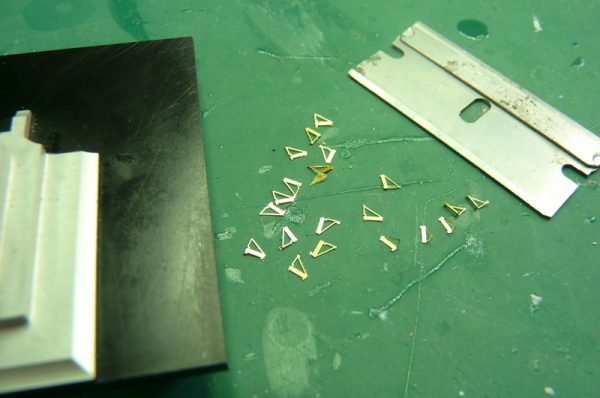
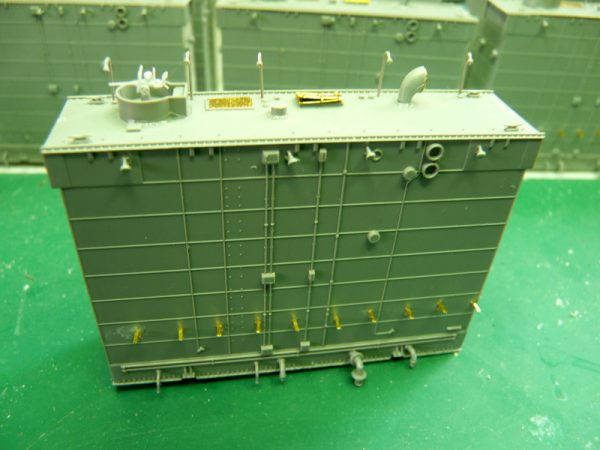
De même pour les petits tuyaux du bas, qui sont tous différents. The same goes for the small pipes at the bottom, which are all different.
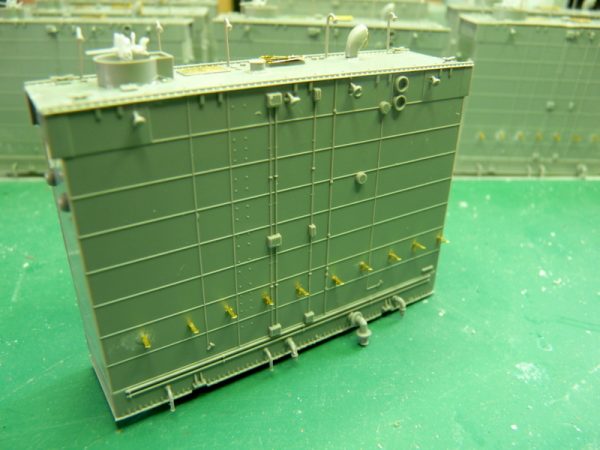
Après ce long travail, mise en ordre de bataille pour la couche d’apprêt en blanc mat à l’aéro ( j’ai du mal avec les bombes de peinture). After this long work, put in order of battle for the primer layer in matt white with the aero (I have trouble with the spray paint).


Gros plan sur ma boulette, avec l’inversion de 4 dessus sur 4 coffres, du coup, il a fallu faire sauter la mitrailleuse pour la mettre de l’autre côté et boucher les trous des lampadaires pour en percer d’autres de l’autre côté. Il n’y a que les trappes que je n’ai pas déplacées. Gageons qu’à l’arrivée cela ne se voit pas trop. Close up on my meatball, with the inversion of 4 tops on 4 chests, so, it was necessary to blow up the machine gun to put it on the other side and to plug the holes of the lampposts to drill others on the other side. There are only the traps that I have not moved. Let’s bet that on arrival it is not too visible.
Tentative de mise en peinture des coffres : après plusieurs essais de gris, j’ai choisi un bleu LIFECOLOR que j’avais en stock . Puis le bleu intermédiaire GUNZE. J’ai fait plusieurs tentatives de patine, j’ai fini avec les produits PANEL LINE TAMIYA et un tube de peinture à l’huile pour tableau OMBRE NATURELLE. Je ne suis pas encore convaincu du résultat, on verra tout cela au finish. Attempt to paint chests: after several tests of gray, I chose a blue LIFECOLOR that I had in stock . Then the intermediate blue GUNZE. I made several patina attempts, I finished with PANEL LINE TAMIYA products and a tube of oil paint for OMBRE NATURELLE painting. I am not yet convinced of the result, we will see all this in the end.
Les barges sont principalement composées de 2 pièces, la coque et le pont. Le pont se pose sur la barge, un peu en force pour que cela rentre dans son logement, du coup tous les raccords sont à mastiquer et à poncer. La mise en peinture se fait à la chaîne. The barges are mainly composed of 2 pieces, the hull and the deck. The bridge lands on the barge, a little in force for it to fit into its housing, so all the fittings are to masticate and sand. The painting is done on a chain.

Puis on colle les « coffres ». Sur les barges, il y a des rambardes à poser. TAKOM propose une rambarde, un seul brin, fin comme un cheveux d’ange. Pour les coller, après la crise de nerf passée, c’est mission impossible. Du coup, on sort la boîte à rabiot et j’en trouve des plus solides. Then we stick the « chests ». On the barges, there are guardrails to put. TAKOM proposes a guardrail, a single strand, fine as an angel’s hair. To stick them, after the last nerve attack, it’s mission impossible. So, we take out the rabiot box and I find more solid.
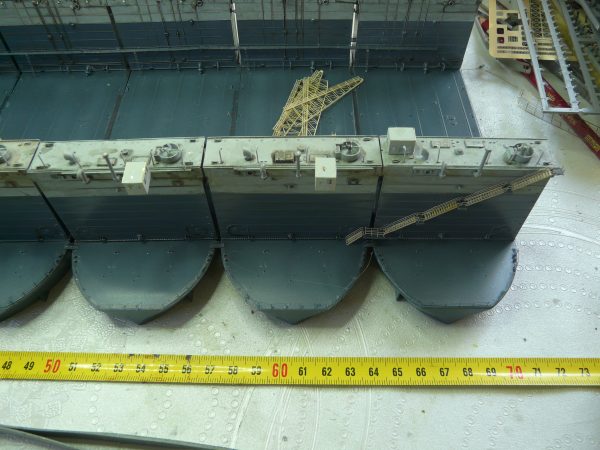
Le chantier devient rapidement très encombrant, avec pas moins de 70 cm de longueur. On se retrousse les manches (au sens propre du terme !) de façon à ne pas accrocher les pièces du dessus, malgré cela quelques lampadaires sautent (sûrement les effets de la tempête !). The site quickly became very cumbersome, with no less than 70 cm in length. We roll up our sleeves (literally!) so as not to hang the pieces from above, despite this some street lamps jump (surely the effects of the storm!).

Pour faire une pause, je monte les deux grues. Deux vraies jolies petites maquettes avec de la photodec, un plaisir ! Les planches de photodec sont vraiment au top. Tout se plie facilement, quasiment à la main sans plieuse. For a break, I climb the two cranes. Two real pretty little models with photodec, a pleasure! The photodec boards are really on top. Everything folds easily, almost by hand without folding.

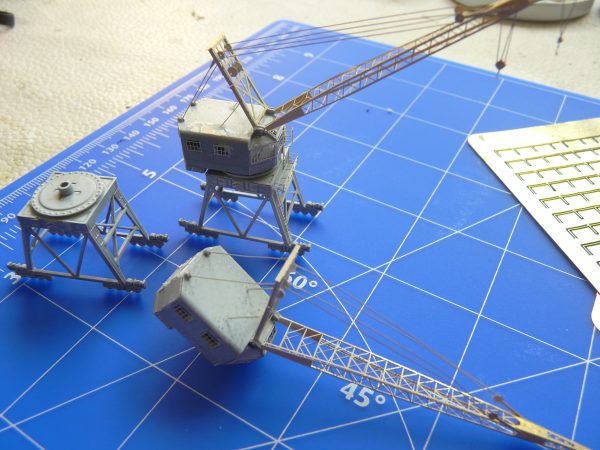
Et puis là ! un gros coup de ras le bol de cet interminable montage. Le tout repart au placard et je sors un avion AIRFIX au 1/48 pour me changer les idées. Les semaines passent……. Je me lance dans une loco blindée allemande au 1/72 où votre serviteur rate entièrement la peinture, elle repart aussitôt dans sa boîte et je ressors le dock flottant. En parallèle, cet été, j’ai attaqué l’USS TEXAS, qui fera l’objet d’un prochain article.
C’est toujours très difficile de reprendre un chantier (vous ne me direz pas le contraire ?). Pour déplacer mon dock, j’ai découpé une planche de contreplaqué 5 mm pour faire un support.
And then there! a big blow of the bowl of this interminable assembly. Everything goes back to the closet and I take out an AIRFIX plane at 1/48 to change my mind. Weeks pass…. I throw myself into a German armored loco at 1/72 where your servant completely misses the painting, it immediately goes back into its box and I leave the floating dock. In parallel, this summer, I attacked the USS TEXAS, which will be the subject of a future article.
It’s always very difficult to take over a construction site (won’t you tell me otherwise?). To move my dock, I cut a 5 mm plywood board to make a support.
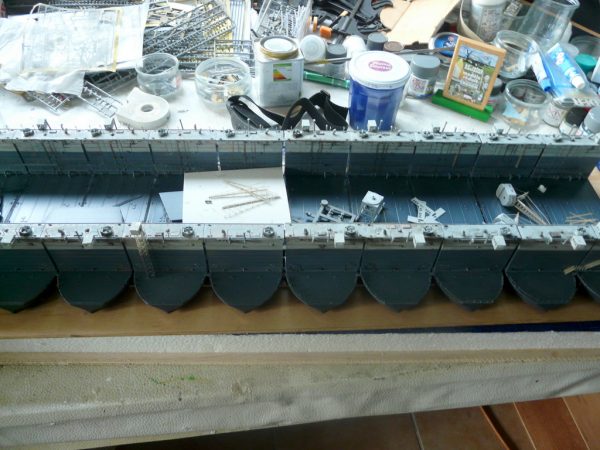
Malgré cela, la manipulation devient impossible, dès que l’on veut le déplacer, ça se décolle de partout, les pièces de photodec tombent comme des mouches. J’ai alors collé le tout définitivement, sur une planche de contreplaqué 3 mm. Du coup, l’ensemble est solidaire et relativement bien rigide. Despite this, manipulation becomes impossible, as soon as you want to move it, it takes off from everywhere, photodec parts fall like flies. I then glued the whole definitively, on a plywood board 3 mm. Suddenly, the whole is solid and relatively well rigid.
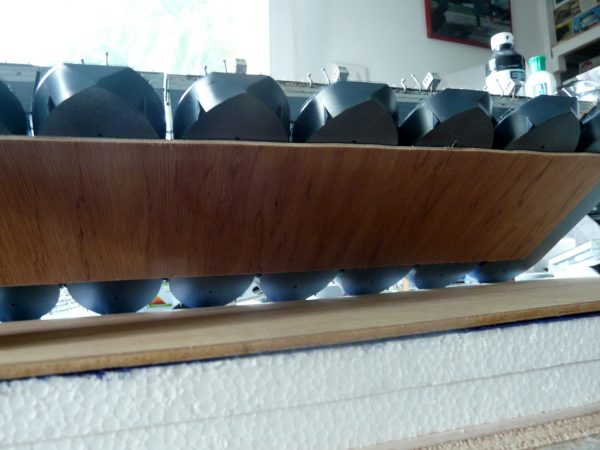
On se rend compte rapidement que c’est difficile de travailler dessus en l’état. Une manche qui accroche une pièce fragile, tout a tendance à partir en « cacahuette » rapidement. J’ai même fait une petite boîte collector pour rassembler toutes les pièces qui veulent s’échapper. J’ai pensé que le plus simple était de le coller définitivement dans son support de futur diorama. Technique habituelle, fond en contreplaqué 10 mm. 30 mm d’épaisseur de polystirène, reproduction de la mer en papier WC, collé à la colle à bois diluée à l’eau, et peinture bleue. We quickly realize that it is difficult to work on it as it is. A handle that hangs a fragile piece, everything tends to go « peanut » quickly. I even made a small collector box to collect all the pieces that want to escape. I thought the easiest way was to stick it permanently in its support of future diorama. Usual technique, plywood bottom 10 mm. 30 mm thick of polystirene, reproduction of the sea in toilet paper, glued with wood glue diluted with water, and blue paint.
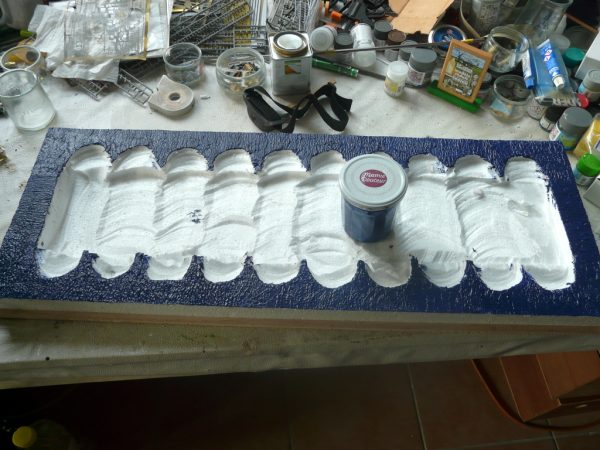
La mise en place du dock, s’avère délicate. Il faudra aggrandir les trous d’accueil. Le collage se fera à la colle à bois. L’ajustage avec un niveau pour contrôler au mieux l’assise du modèle The installation of the dock is difficult. It will be necessary to enlarge the reception holes. The gluing will be done with wood glue. Adjustment with a level to better control the model’s seat
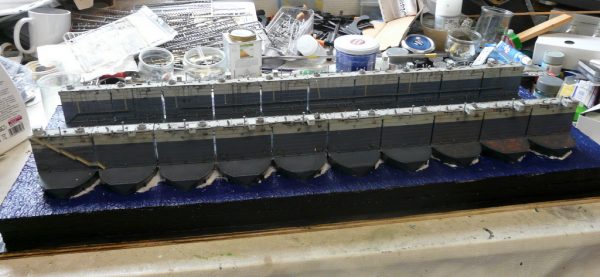
Après, il faudra boucher les excès de découpe avec du papier WC qui sera ensuite peint en bleu. Pose de quelques pièces en photodec, je n’en vois pas le bout. After, it will be necessary to plug the excess of cutting with paper WC which will then be painted in blue. Pose of some parts in photodec, I do not see the end.
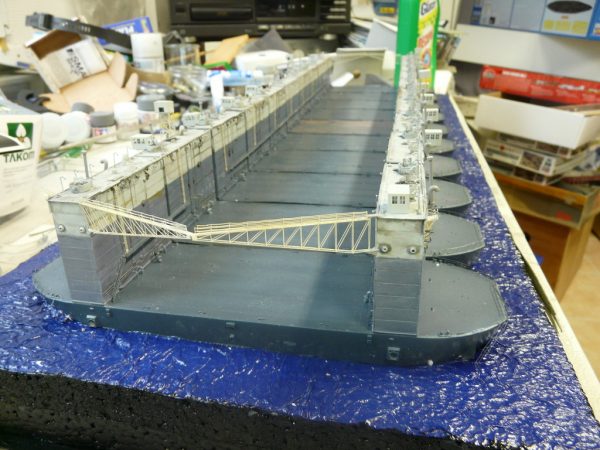
Et pour changer un peu, retour dans le plastique, pour la découpe des tins ( chacune des pièces de bois qui soutiennent la coque d’un navire en construction). Il y en a 58 par grappe et il y a 12 grappes !!!!!!!!!!!!! Découpe patiente et pose sur un support double face pour la mise en peinture. Un coup de noir à l’aéro qui prend une petite minute et le tour est joué. And to change a little, back in the plastic, for the cutting of tins (each of the pieces of wood that support the hull of a ship under construction). There are 58 per cluster and there are 12 clusters!!!!!!!!!!!! Patient cutting and laying on a double-sided support for painting. A blow of darkness to the aero that takes a minute and it’s done.
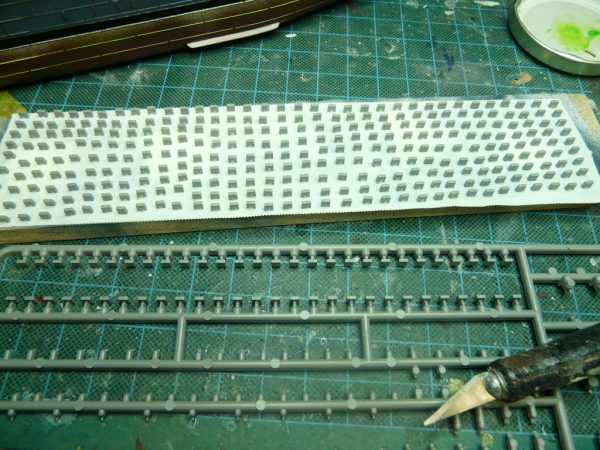
Sur le plan (il faut bien ouvrir les yeux !) il y a 5 lignes de tins. Après mesure, j’ai tiré un cordeau pour aligner la ligne du milieu. Puis j’ai découpé deux gabarits en carton (un peu au pif !) pour les autres lignes. Le tout est collé à la colle blanche TAMIYA. C’est très long et très fastidieux……. On the plane (you have to open your eyes) there are 5 lines of tins. After measuring, I pulled a line to align the middle line. Then I cut two cardboard templates (a little by the nose!) for the other lines. The whole is glued to the white glue TAMIYA. It’s very long and very tedious…….
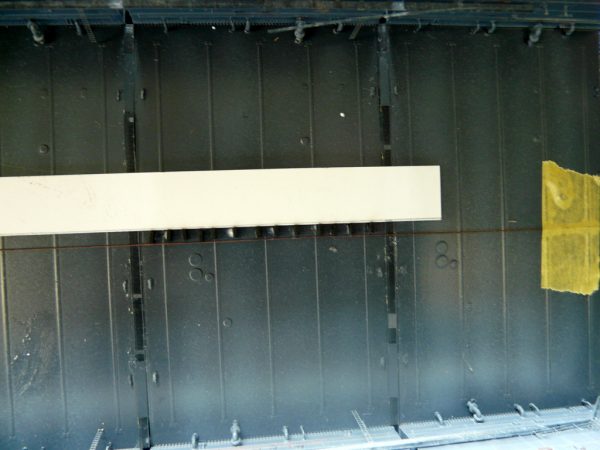
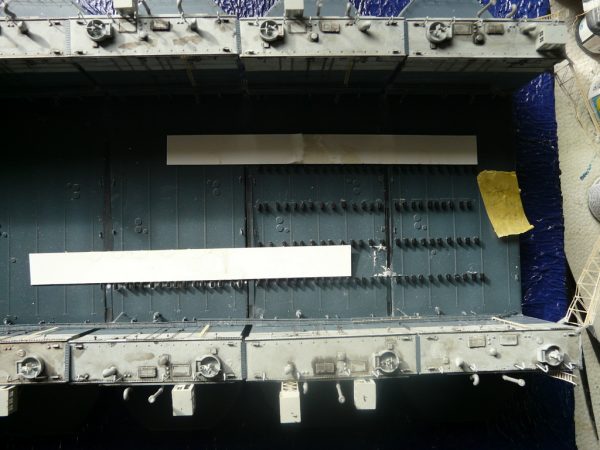
Il faudra plusieurs jours pour aligner les tins. Pour ceux qui sont sous le bateau, j’ai triché, en taillant des cales de bois de la bonne épaisseur….. It will take several days to align the tins. For those who are under the boat, I cheated, by cutting wooden holds of the right thickness…..
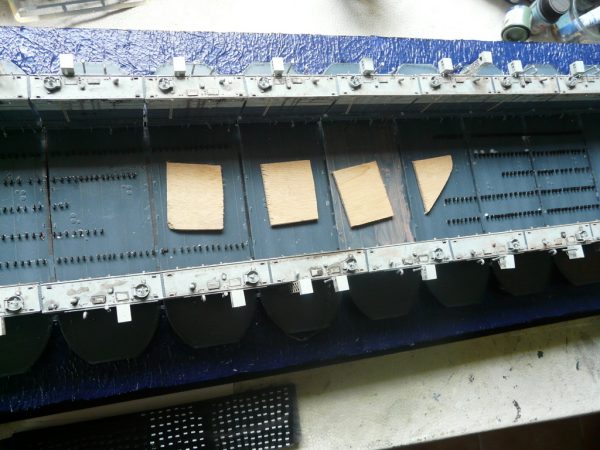
Pose de la bête dans son dock, cela prend forme, encore 17 ans de boulot pour finir, je n’en vois pas le bout… Put the beast in its dock, it takes shape, another 17 years of work to finish, I do not see the end…

A suivre, To be continued
Topo, photos et montage : ALPERS


